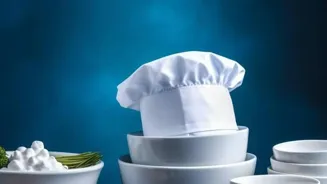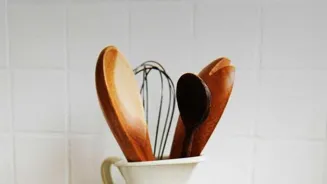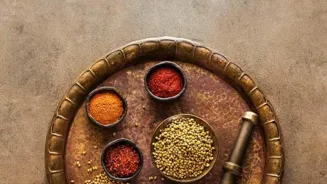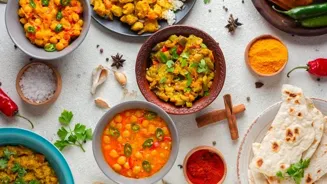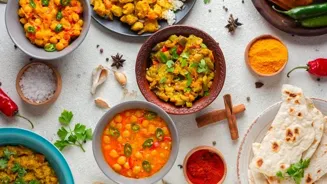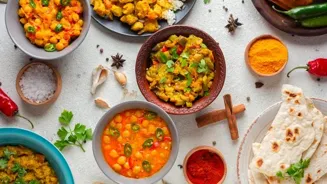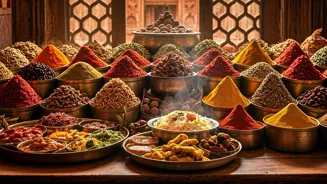Discover 7 Essential Indian Cooking Techniques to Elevate Your Culinary Skills & Create Memorable Meals!
Are you bored of making the same old dishes? Want to impress your family and friends with your amazing
cooking skills? Don't worry, you don't need to go to a fancy culinary school. With a little practice and the right knowledge, you can become a whiz in your own kitchen.
Here are seven essential cooking techniques that every Indian home chef should master to elevate their daily cooking and create truly memorable vegetarian meals. From perfectly tempered spices to fluffy rice every time, these skills will unlock a world of flavor and culinary confidence.
So, grab your apron, sharpen your knives (safely, of course!), and get ready to embark on a tasty adventure. Let's transform you from a simple cooker to a confident chef!
The Art of Tempering (Tadka/Bhagar): The Foundation of Flavour
Tempering, also known as tadka, bhagar, or chaunk, is a cornerstone of Indian cooking. It's the technique of heating oil or ghee and then adding spices like mustard seeds, cumin seeds, dried red chilies, asafoetida (hing), and curry leaves.
The hot oil infuses with the aroma and flavor of the spices, releasing their essential oils and creating a fragrant and flavourful base for dals, vegetables, and curries. The order in which you add the spices matters.
Start with the spices that take longer to release their flavor, like mustard seeds and cumin seeds, and then add the others. Be careful not to burn the spices, as this will result in a bitter taste. The key is to heat the oil or ghee until it's hot but not smoking.
Learning to temper correctly will enhance the depth and aromatic complexity of your vegetarian preparations. This small technique contributes significantly to enhanced flavor and fragrant essence. A well prepared tempting tempering makes a huge impact on the aroma and the palatability.
Mastering the Art of Sautéing: Quick Cooking for Vibrant Dishes
Sautéing is a quick and easy cooking method that involves cooking ingredients in a small amount of fat over relatively high heat. It's perfect for vegetables, paneer, and even some types of lentils. The key to successful sautéing is to use a pan with a wide surface area and to not overcrowd it.
Overcrowding the pan will lower the temperature and cause the ingredients to steam instead of sauté. Cut your ingredients into uniform sizes so that they cook evenly. Keep the food moving in the pan by stirring or tossing frequently so it cooks evenly and doesn't stick to the pan.
Sautéing is a great way to quickly cook vegetables while retaining their crispness and nutritional value. It is also a great way to develop flavors, as the high heat helps to caramelize the sugars in the food. Using aromatic ingredients such as ginger and garlic in sautéing adds to the flavour.
The Secret to Perfect Rice: Every Grain Separate and Fluffy
Rice is a staple in many Indian homes, and mastering the art of cooking perfect rice is essential. There are several methods for cooking rice, but the absorption method is one of the most common and reliable. For this method, rinse the rice thoroughly to remove excess starch.
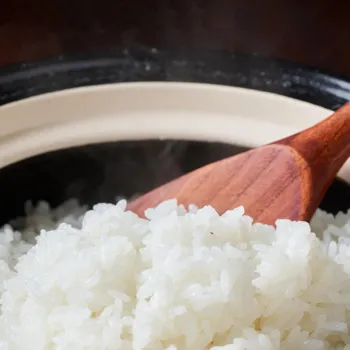
This will prevent the rice from becoming sticky. Use the correct ratio of water to rice. A general rule of thumb is to use 2 cups of water for every 1 cup of rice. Bring the water to a boil, then add the rice and salt.
Reduce the heat to low, cover the pot tightly, and simmer for 15-20 minutes, or until all the water has been absorbed. Do not lift the lid during cooking. Once the rice is cooked, let it rest for 5-10 minutes before fluffing it with a fork.
This will allow the steam to redistribute and prevent the rice from becoming mushy. Some people like to add a teaspoon of ghee at the stage when the water reduces. Learning to cook perfect rice every time will transform your meal times.
The Magic of Roasting: Bringing Out the Best in Vegetables and Spices
Roasting is a dry-heat cooking method that involves cooking food in an oven. It's a great way to bring out the natural sweetness and flavors of vegetables and spices. Roasting vegetables at a high temperature helps to caramelize the sugars, creating a delicious, slightly crispy exterior.
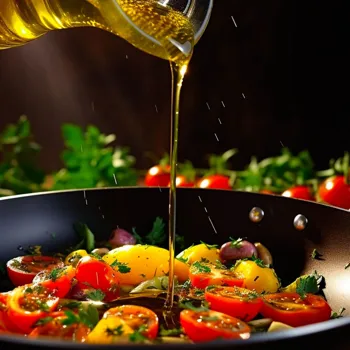
Before roasting vegetables, toss them with oil and your favorite seasonings. Spices like cumin, coriander, and turmeric become more fragrant and flavorful when roasted. You can also roast whole spices and then grind them to create your own custom spice blends.
Experiment with different vegetables and spices to discover your favorite flavor combinations. Ensuring the correct temperature for a suitable cooking time is crucial. With the right temperature and technique, roasting can be so simple.
The Gentle Art of Steaming: Healthy and Nutritious
Steaming is a gentle cooking method that uses steam to cook food. It's a healthy way to preserve the nutrients in vegetables, as it doesn't require the use of oil. To steam vegetables, you can use a steamer basket inserted into a pot with a small amount of water.
Bring the water to a boil, then reduce the heat and cover the pot. The steam will gently cook the vegetables without them becoming waterlogged. Steaming is also a great way to cook idlis, dhoklas, and other Indian snacks and desserts.
Experiment with different vegetables and seasonings to create healthy and delicious steamed dishes. The gentle steaming helps preserve the nutrients and gives a palatable taste. Steaming is a very versatile method that you can use in a number of options.
Braising: A Technique for Transforming Vegetables and Pulses
Braising is a combination cooking method that involves searing the food first, then simmering it in liquid for a long time. This technique is particularly well-suited for tougher vegetables like potatoes, cauliflower, and beans, as well as pulses like dried peas and beans.
The long, slow cooking process tenderizes the vegetables and pulses and allows the flavors to meld together. To braise, sear the vegetables in a hot pan with oil until they are browned on all sides. Then, add liquid, such as broth, water, or tomato sauce, and bring to a simmer.
Cover the pan and cook until the vegetables are tender. Braising enhances the flavour which makes a dish more tempting to consume. Slow cooking provides a more natural taste than fast cooking in an Indian kitchen. Braising is a method that helps tenderise food components and also adds flavour.
The Importance of Spice Blends: Creating Your Signature Flavors
Indian cuisine is known for its complex and aromatic spice blends. While you can buy pre-made spice blends, creating your own allows you to customize the flavors to your liking. Start by experimenting with a few basic spice blends, such as garam masala, sambar powder, and chaat masala.
Once you are comfortable with the basics, you can start experimenting with your own unique combinations. To make a spice blend, simply combine the spices in a bowl and mix them together. Store the spice blend in an airtight container in a cool, dark place.
Experiment with different spices and ratios to create spice blends that perfectly complement your favorite dishes. This really takes us back to the spice route ancient india once traversed bringing in flavours from across geography helping cook up a magical spice blend.
By mastering these seven essential cooking techniques, you'll be well on your way to becoming a confident and creative cook in your home. So, get into the kitchen, experiment with flavours, and most importantly, have fun! Happy cooking!
